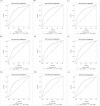Development and validation of a risk prediction model for chronic kidney disease among individuals with type 2 diabetes
- PMID: 35314714
- PMCID: PMC8938464
- DOI: 10.1038/s41598-022-08284-z
Development and validation of a risk prediction model for chronic kidney disease among individuals with type 2 diabetes
Abstract
Many studies had established the chronic kidney disease (CKD) prediction models, but most of them were conducted on the general population and not on patients with type 2 diabetes, especially in Asian populations. This study aimed to develop a risk prediction model for CKD in patients with type 2 diabetes from the Diabetes Care Management Program (DCMP) in Taiwan. This research was a retrospective cohort study. We used the DCMP database to set up a cohort of 4,601 patients with type 2 diabetes without CKD aged 40-92 years enrolled in the DCMP program of a Taichung medical center in 2002-2016. All patients were followed up until incidences of CKD, death, and loss to follow-up or 2016. The dataset for participants of national DCMP in 2002-2004 was used as external validation. The incident CKD cases were defined as having one of the following three conditions: ACR data greater than or equal to 300 (mg/g); both eGFR data less than 60 (ml/min/1.73 m2) and ACR data greater than or equal to 30 (mg/g); and eGFR data less than 45 (ml/min/1.73 m2). The study subjects were randomly allocated to derivation and validation sets at a 2:1 ratio. Cox proportional hazards regression model was used to identify the risk factors of CKD in the derivation set. Time-varying area under receiver operating characteristics curve (AUC) was used to evaluate the performance of the risk model. After an average of 3.8 years of follow-up period, 3,067 study subjects were included in the derivation set, and 786 (25.63%) were newly diagnosed CKD cases. A total of 1,534 participants were designated to the validation set, and 378 (24.64%) were newly diagnosed CKD cases. The final CKD risk factors consisted of age, duration of diabetes, insulin use, estimated glomerular filtration rate, albumin-to-creatinine ratio, high-density lipoprotein cholesterol, triglyceride, diabetes retinopathy, variation in HbA1c, variation in FPG, and hypertension drug use. The AUC values of 1-, 3-, and 5-year CKD risks were 0.74, 0.76, and 0.77 in the validation set, respectively, and were 0.76, 0.77, and 0.76 in the sample for external validation, respectively. The value of Harrell's c-statistics was 0.76 (0.74, 0.78). The proposed model is the first CKD risk prediction model for type 2 diabetes patients in Taiwan. The 1-, 3-, and 5-year CKD risk prediction models showed good prediction accuracy. The model can be used as a guide for clinicians to develop medical plans for future CKD preventive intervention in Chinese patients with type 2 diabetes.
© 2022. The Author(s).
Conflict of interest statement
The authors declare no competing interests.
Figures



Similar articles
-
ESKD Risk Prediction Model in a Multicenter Chronic Kidney Disease Cohort in China: A Derivation, Validation, and Comparison Study.J Clin Med. 2023 Feb 14;12(4):1504. doi: 10.3390/jcm12041504. J Clin Med. 2023. PMID: 36836039 Free PMC article.
-
Risk of onset of chronic kidney disease in type 2 diabetes mellitus (ROCK-DM): Development and validation of a 4-variable prediction model.Prim Care Diabetes. 2025 Jun;19(3):312-321. doi: 10.1016/j.pcd.2025.02.005. Epub 2025 Feb 18. Prim Care Diabetes. 2025. PMID: 39971657
-
A prediction model on incident chronic kidney disease among individuals with type 2 diabetes in the United States.Diabetes Obes Metab. 2023 Oct;25(10):2862-2868. doi: 10.1111/dom.15177. Epub 2023 Jun 19. Diabetes Obes Metab. 2023. PMID: 37334525
-
Risk score system for the prediction of hepatocellular carcinoma in patients with type 2 diabetes: Taiwan Diabetes Study.Semin Oncol. 2018 Oct;45(5-6):264-274. doi: 10.1053/j.seminoncol.2018.07.006. Epub 2018 Oct 17. Semin Oncol. 2018. PMID: 30342872 Review.
-
Risk Prediction Score for Chronic Kidney Disease in Healthy Adults and Adults With Type 2 Diabetes: Systematic Review.Prev Chronic Dis. 2023 Apr 20;20:E30. doi: 10.5888/pcd20.220380. Prev Chronic Dis. 2023. PMID: 37079751 Free PMC article.
Cited by
-
A SuperLearner approach for predicting diabetic kidney disease upon the initial diagnosis of T2DM in hospital.BMC Med Inform Decis Mak. 2025 Mar 26;25(1):148. doi: 10.1186/s12911-025-02977-x. BMC Med Inform Decis Mak. 2025. PMID: 40140809 Free PMC article.
-
External validation of a minimal-resource model to predict reduced estimated glomerular filtration rate in people with type 2 diabetes without diagnosis of chronic kidney disease in Mexico: a comparison between country-level and regional performance.Front Endocrinol (Lausanne). 2024 Mar 22;15:1253492. doi: 10.3389/fendo.2024.1253492. eCollection 2024. Front Endocrinol (Lausanne). 2024. PMID: 38586458 Free PMC article.
-
Chronic kidney disease risk assessment: Findings from backward-looking study using annual health check-up data in Japan.Diabetes Obes Metab. 2025 Jul;27(7):3686-3694. doi: 10.1111/dom.16390. Epub 2025 Apr 14. Diabetes Obes Metab. 2025. PMID: 40230182 Free PMC article.
-
Global Validation of a Model to Predict Reduced Estimated GFR in People With Type 2 Diabetes Without Diagnosis of CKD.Kidney Int Rep. 2024 Apr 4;9(7):2047-2055. doi: 10.1016/j.ekir.2024.04.005. eCollection 2024 Jul. Kidney Int Rep. 2024. PMID: 39081746 Free PMC article.
-
Challenges in predictive modelling of chronic kidney disease: A narrative review.World J Nephrol. 2024 Sep 25;13(3):97214. doi: 10.5527/wjn.v13.i3.97214. World J Nephrol. 2024. PMID: 39351189 Free PMC article. Review.
References
-
- WHO. (2020). https://www.who.int/news-room/fact-sheets/detail/diabetes. Accessed 26 October 2020.
-
- Lin YC, et al. Incidence and prevalence of ESRD in Taiwan renal registry data system (TWRDS): 2005–2012. Acta Nephrologica. 2014;28:65–68.
Publication types
MeSH terms
Substances
LinkOut - more resources
Full Text Sources
Medical
Research Materials
Miscellaneous

